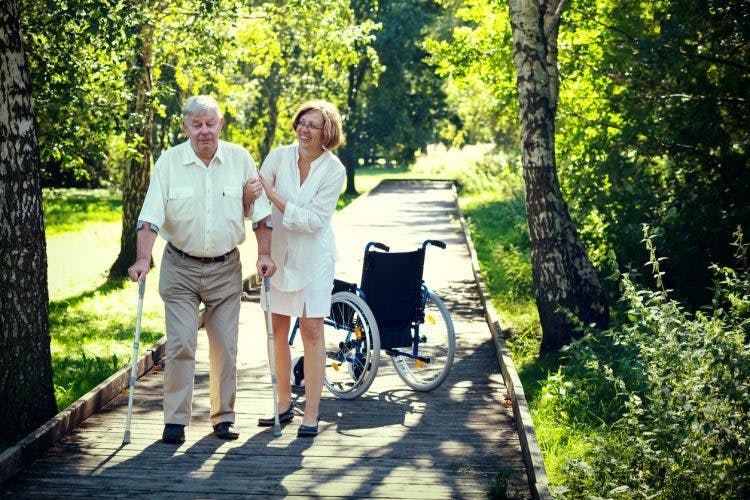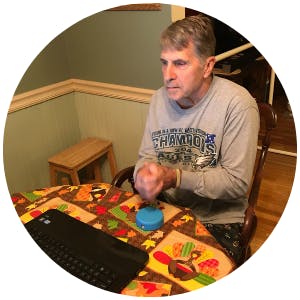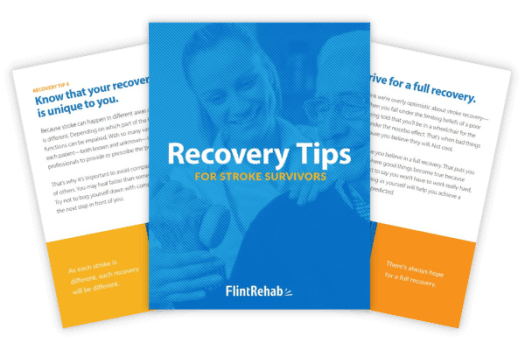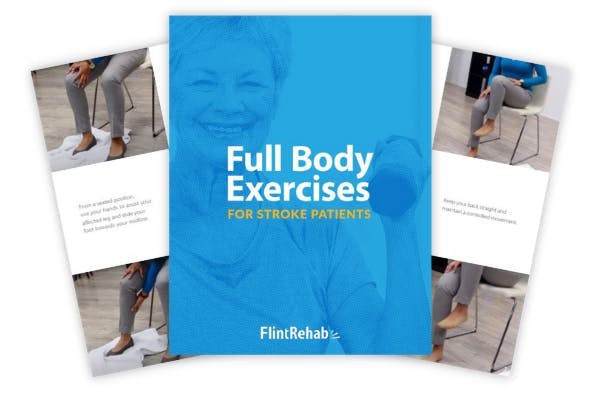No products in the cart.
No products in the cart.
No products in the cart.
No products in the cart.
Home » Neurological Recovery Blog » Stroke » What Are the Chances of Recovery from Stroke Paralysis? Exploring Studies & Methods
Last updated on March 25, 2024

After a stroke, many survivors and caregivers wonder what are the chances of recovery from stroke paralysis? This is a valid question, as paralysis and other secondary effects of stroke can have a major impact on daily function and a survivor’s independence.
However, there is no simple answer to this question. Every stroke is different, and therefore, every recovery will be different. Recovery from stroke can be a lengthy process, and every survivor will need to find what methods work for them to help increase their chances of full recovery from stroke paralysis.
To help shed some light on post-stroke paralysis and what the rehabilitation process entails, this article will discuss the important factors that influence recovery success. Additionally, we will review some effective treatment methods to help you get started, and share a success story to encourage you on your journey.
Use the links below to jump straight to any section:
After a stroke, many survivors experience weakness or paralysis of one half of the body, called hemiplegia or hemiparesis. In this article, we will primarily be discussing hemiplegia, the more severe of the two.
This paralysis of one-half of the body occurs when areas of the brain responsible for movement, like the motor cortex, are damaged due to stroke. When this damage occurs, the communication pathways from the brain to the muscles are disrupted. As a result, the muscles are left in a state of paralysis. This can negatively impact a survivor’s function and contribute to other complications like muscle atrophy.
The brain is divided into two hemispheres, or halves, and each hemisphere is responsible for motor function on the opposite side of the body. For this reason, damage to the right hemisphere of the brain can lead to left hemiplegia, and a left hemisphere stroke can result in right hemiplegia.
If you are concerned about your chances of recovery from stroke paralysis, it’s important to understand that stroke recovery is highly individualized. Every stroke is different and every brain is wired uniquely, therefore recovery is unique to every person. Additionally, a survivor’s recovery can depend on their health status before the stroke. This can make it difficult to predict the outcomes of any particular case of post-stroke paralysis.
Fortunately, there is substantial clinical evidence that shows a positive correlation between the intensity and consistency of rehabilitation and recovery after stroke. This is an important factor to consider when evaluating your own recovery efforts.
The size and location of a stroke are two other important factors influencing recovery. Generally, when a stroke is severe or affects larger areas of the brain, the effects can be more substantial. And therefore a full recovery less likely. As we mentioned before, each area of the brain has a distinct function. The area of the brain affected by the stroke and that area’s primary functions will determine the resulting secondary effects.
These effects can include changes in vision, speech, balance, and even behavioral changes in addition to post-stroke paralysis. To gain better insight into the chances of recovery from stroke paralysis, let’s take a look at the rehabilitation process more closely.
As we reviewed previously, paralysis after stroke is the result of disrupted communication between the brain and muscles. When the brain cannot send the correct signals to your affected muscles, they become difficult to move or, in cases of hemiplegia, paralyzed.
Between 70-85% of stroke survivors experience hemiplegia following their first stroke. Although this is a staggering statistic, functional recovery is possible for survivors affected by hemiplegia through dedicated rehabilitation.
This is because the brain is capable of rewiring itself and bouncing back from injury. While many stroke survivors might not achieve a full recovery, functional gains are possible with the right approach and circumstances. This process depends on neuroplasticity after stroke.
Neuroplasticity is the brain’s innate ability to rewire itself and learn new skills. Through this process, functions that were lost due to stroke can be relearned by undamaged areas of the brain. This rewiring occurs based on experiences and the repetitive practice of exercises and functional tasks.
For example, no one is born knowing how to ride a bike. It’s the practice and experience that allows us to acquire this skill. Riding a bike becomes easier by attempting to ride a bike over and over.
The same concept applies to stroke rehabilitation, including recovery from post-stroke paralysis. Before we discuss these specific treatments for stroke paralysis, let’s examine why consistent rehabilitation is so important.
Want 25 pages of stroke recovery exercises in a PDF? Click here to download our free Stroke Rehab Exercise ebook now (link opens a pop up for uninterrupted reading)
One recent study found that nearly 25% of survivors affected by severe stroke and hemiplegia were able to return to independent living. Additionally, many others were able to improve their function and performance of activities of daily living. This greater recovery was found to be correlated with more intensive rehabilitation interventions.
During rehabilitation, the fastest recovery is generally seen during the first 3-6 months after stroke. This is when neuroplasticity is at its strongest and the brain is working to heal and rewire neural connections that were lost due to stroke. This boosted neuroplasticity is primarily responsible for what is called spontaneous recovery, referring to the rapid gains in function seen early in the recovery process.
Many survivors undergo inpatient rehab during this time, which requires 3 hours of therapy per day. This intensive rehabilitation helps survivors capitalize on boosted neuroplasticity and spontaneous recovery to see fast improvements in physical function. However, it is vital that stroke survivors continue rehabilitation at home after inpatient rehabilitation is over.
Without constant participation in therapy, progress can plateau or even regress after stroke. For instance, another study followed stroke patients 5 years post-stroke and found that “the level of functional and motor performance at 5 years post-stroke was equivalent to the level measured at 2 months.”
Researchers credit the intensity of inpatient rehabilitation for the initial gains during the first 2 months. To keep recovery going, there must be consistent therapy at home after inpatient rehab is over.
Another study analyzed the impact of long-term rehabilitation by gathering 51 stroke patients who could not walk 3 months post-stroke. After two years of long-term rehabilitation, 74% of participants regained their ability to walk without assistance. This shows that when rehabilitation is pursued long-term, the prognosis becomes more optimistic.
There are a variety of rehabilitation activities after stroke. It’s important to experiment and find what exercises are effective for you. Work closely with your therapy team to create a rehab program that will help you reach your own unique goals.
Once you find something that works, try your best to see it through daily. It cannot be stressed enough: long-term rehabilitation is the key to recovery from stroke. When performing your exercises, keep in mind that high repetition (sometimes called massed practice) is necessary to promote the rewiring of neural connections.
To make lasting changes, dedicate yourself to performing high repetitions of these exercises and skills. To help you get started, let’s review some different stroke paralysis treatments to maximize your chances of recovery:
It’s important to work closely with your medical team to establish your rehabilitation regimen. As you notice yourself progressing, adjust to challenge yourself daily. If you start to see the return of muscle activity, progress to more active exercises.
To help yourself stay consistent, try creating a daily schedule or log and find an accountability partner. Once established, continue with your exercises daily at home because your brain needs lots of repetitions of movement to adapt and change.
A stroke survivor named Ron once struggled with arm paralysis after stroke. Here is his recovery story as told by his wife:

“My husband suffered a stroke caused by a dissecting carotid artery in late May of this year. He lost 40% of his left hemisphere of his brain causing right side paralysis.
His speech was slightly impaired but thankfully Drs believe he is a rare left-handed person with speech located in right hemisphere of his brain! Ron was in ICU for a week, followed by a rehab hospital for five more weeks. He came home and has done outpatient therapy three days a week since.
About three weeks ago I ordered the FitMi and just this past week he moved his arm for the very first time!!! He and I both think the repetitive movement of the arm has given his brain the signal that it’s there and ready to move!!!
He will continue with both the FitMi and his other therapies for as long as it takes to fully recover!!!“
Ron’s story illustrates how the brain responds to experience. His affected arm regained small amounts of movement by passively practicing arm exercises with FitMi home therapy regularly. FitMi is an ideal recovery system for stroke patients pursuing rehab at home because it adjusts to your ability level. Even survivors struggling with paralysis can use FitMi to exercise passively, just like Ron.
Not everyone is guaranteed to recover like Ron, but we hope his story may inspire you to explore your potential. You’ll never know what your chances of a recovery from stroke paralysis are until you try.
A majority of survivors experience hemiplegia or other varying levels of paralysis after stroke. While this secondary effect can have a major impact on function and independence, recovery from stroke paralysis is possible through dedicated rehabilitation. This recovery is thanks to neuroplasticity, or the brain’s ability to rewire neural pathways responsible for movement.
With help from your therapy team, experiment with different rehabilitation techniques to find what works for you. Then, stay consistent with high repetitions of your therapy exercises to maximize your chances of recovery from stroke paralysis. As you continue to pursue rehabilitation, you may find that you can progress your exercises and restore muscle activity in your affected limbs.
Find ways to stay accountable and feel free to customize your recovery plan to include activities that you enjoy. The more you enjoy your exercises, the more often you will do them. We hope this helps you feel inspired to continue pursuing your goals to maximize your chances of recovery from post-stroke paralysis.

Get our free stroke recovery ebook by signing up below! It contains 15 tips every stroke survivor and caregiver must know. You’ll also receive our weekly Monday newsletter that contains 5 articles on stroke recovery. We will never sell your email address, and we never spam. That we promise.


Do you have these 25 pages of rehab exercises?
Get a free copy of our ebook Full Body Exercises for Stroke Patients. Click here to get instant access.
“My name is Monica Davis but the person who is using the FitMi is my husband, Jerry. I first came across FitMi on Facebook. I pondered it for nearly a year. In that time, he had PT, OT and Speech therapy, as well as vision therapy.
I got a little more serious about ordering the FitMi when that all ended 7 months after his stroke. I wish I hadn’t waited to order it. He enjoys it and it is quite a workout!
He loves it when he levels up and gets WOO HOOs! It is a wonderful product! His stroke has affected his left side. Quick medical attention, therapy and FitMi have helped him tremendously!”
FitMi is like your own personal therapist encouraging you to accomplish the high repetition of exercise needed to improve.
When you beat your high score or unlock a new exercise, FitMi provides a little “woo hoo!” as auditory feedback. It’s oddly satisfying and helps motivate you to keep up the great work.
In Jerry’s photo below, you can see him with the FitMi pucks below his feet for one of the leg exercises:
Many therapists recommend using FitMi at home between outpatient therapy visits and they are amazed by how much faster patients improve when using it.
It’s no surprise why over 14,000 OTs voted for FitMi as “Best of Show” at the annual AOTA conference; and why the #1 rehabilitation hospital in America, Shirley Ryan Ability Lab, uses FitMi with their patients.
This award-winning home therapy device is the perfect way to continue recovery from home. Read more stories and reviews by clicking the button below:
Grab a free rehab exercise ebook!
Sign up to receive a free PDF ebook with recovery exercises for stroke, traumatic brain injury, or spinal cord injury below: